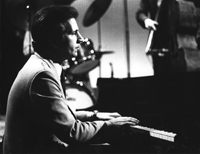Berklee Today
Ray Santisi: Staying Young
By Peter Gerstenzang '77
 |
|
| Professor Ray Santisi circa 1975 |
"I came to Berklee in the early 50s on scholarship to study and started teaching here in 1957," Santisi says. "There were some very cool people here at the time studying along with me-guys like Quincy Jones, Herb Pomeroy, and Charlie Mariano. In those days there weren't a lot of places to play, but we always found some little gin mill. One of my fondest memories from those days was being able to play with Charlie Parker."
And what lessons, one wonders, did the legendary saxophonist impart to the young bebopper? "He told me something that has stayed with me to this day. We were playing, 'I'll Remember April,' and I was trying to impress Bird with all these chords, just filling up the tune. Parker stopped the song and said, 'I want to be able to stop at any point and play the melody and some of those chords you're using just don't fit. What you're playing should always fit.' Bird taught me to make sure that things gel when you play, and to never get away from the melody!"
Some time later, Santisi, turned entrepreneur, ran a club called the Stables with Charlie Mariano. It eventually evolved into the venerable Jazz Workshop on Boylston Street. He also started recording with some of the leading lights of 60s and 70s jazz.
"I did several records with [trumpeter] Donald Byrd and things with people like Stan Kenton and Buddy De Franco. Possibly the most satisfying dates of my life were the two records I did with singer Irene Kral, Band In Boston, and Band and I. She was the most incredible singer I've ever known. It was terrible that she had to die so young."
Santisi's formidable resume also lists his instructional book, Jazz Originals for Piano, an honor scholarship to Schillinger House, and other honors-which must include, of course, raves for his playing. Santisi has been called, "Boston's most in-demand jazz pianist," by the Boston Phoenix, "A joy," by Cadence magazine, and "A man sitting on top of the world, professionally speaking," by Boston Globe jazz critic, Ernie Santusuosso.
Then, there are his students. Although one nearly has to pry the names out of the modest Santisi, the list of people who have studied with him is simply staggering. It includes, Joe Zawinul, Keith Jarrett, Jane Ira Bloom, and a reasonably successful singer-pianist, by the name of Diana Krall. According to Santisi, the world can very possibly thank him for the fact that Ms. Krall is as well known for her singing as her playing.
"Diana was always a terrific pianist, she used a great deal of economy in her playing, like Count Basie. She actually told me, too, that her phrasing on the keyboard was also influenced by people like comedian Alan King, the brevity, the use of punch lines. One day during a lesson, I simply asked her, can you sing something? Apparently she had never or rarely done that. The minute she started, I said 'Don't stop.' She had a lovely, natural voice, perfect control and a nice vibrato."
Just for that accomplishment alone, I think I speak for the world when I say, "Thanks Ray." A recent student, Masako Yotsugi, waxes ecstatic about Ray's abilities as an instructor. "Ray teaches organic things," Yotsugi says. "Not somebody's copy or transcription. I've also learned the fine art of applied theory and reharmonization because of his teaching gifts. Then, there's his playing. It is very spontaneous and entertaining, with a first-class swing appeal. "I always keep these things in mind when I play for people," says this fine, young pianist.
Getting back to that (unspoken) age thing, Santisi is one those instructors who seems to stay so young because he gets as much back, musically and symbolically, from the young people he teaches, as they get from him.
"I feel like I'm constantly learning from my students," Santisi says. "They're always exciting to be around. You know, you take your influences where you find them. So if one of my students does a nice funk thing, or has a way of phrasing that appeals to me, I incorporate it into my own playing just as these kids incorporate things I show them. It bleeds into my playing live. So, it's a very healthy thing, being a player and a teacher."
